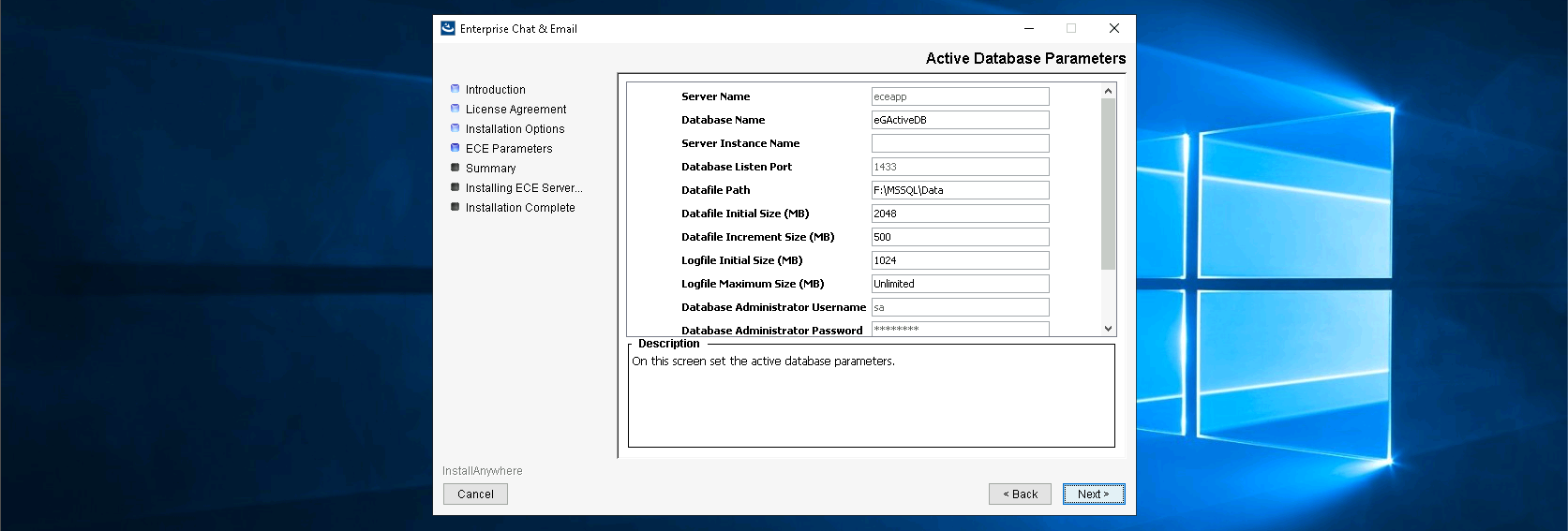Cisco ECE (Enterprise Chat & Email)
Cisco Enterprise Chat and Email (ECE) is an integrated solution designed for managing customer interactions via chat and email. Part of the Cisco Contact Center suite, ECE enhances customer service by providing efficient multi-channel support.
Installation on ECE Data Server
Prerequisites needed before installation is a clean Windows Server with SQL Installed
Then just run the ECE installer
Set to install everything except the Web Server
Provide the installation path
Then set some ports which we should just leave the default values
- Jetty is an open-source Java-based web server used to serve ECE App web applications.
- ActiveMQ serves as the messaging backbone that facilitates communication between different components of the system.
- ActiveMQ is used to queue and manage messages, ensuring that information such as chat requests, email routing, and agent notifications are efficiently handled and delivered.
- RMI (Remote Method Invocation) is a Java API that allows objects to invoke methods on remote objects located on different JVMs (Java Virtual Machines).
- It facilitates communication between applications running on separate systems by enabling the execution of methods as if they were on the local machine.
Next set the context root name, which we also leave the default
Next give it the System Admin and Partiiton Admin credentials
Next set the installation name and a unique 4 digits identifier value
After that, select the SQL Auth method
Then fill up the details for the MasterDB and ActiveDB
- MasterDB serves as the primary database, storing configuration, historical, and operational data crucial for the system’s functioning. It handles read-write operations and stores static information like user accounts and system settings.
- ActiveDB manages real-time operational data such as ongoing chat sessions and email interactions. It optimizes performance by offloading live data processing from MasterDB, ensuring better responsiveness. ActiveDB synchronizes with MasterDB to maintain data consistency.
Next set the DB Path which we sould aldo leave the default values
After that configure the details for the ReportsDB
- ReportsDB serves as a dedicated repository for storing and managing reporting data. It collects, aggregates, and organizes information related to performance metrics, agent activities, and customer interactions.
Also set the DB Path
Next, set the SQL user
And the domain user
And finally, review the configuration and proceed with installation
After awhile, we should have the services installed on ECE Data Server
Installation on ECE Web Server
On the ECE Web Server, all that’s needed is a fresh Windows Server and we can proceed to run the installer
Here we point it to the ECE Data Server hostname
Then provide the installation path
Next select the IIS Web Site Name
Then match the context root name as configured on the data server
Same goes with the partition
And provide the domain user
Review the configuration and hit install
After a minute the Web Service should be installed on ECE Web Server
Here make sure the URL Rewrite is pointing to the ECE Data Server
After some minutes, the ECE Web Console should be accessible
PCCE Integration
On CCE Admin, add both the Data Server and the Web Server
Now the ECE Widget should show up on the CCE Admin Overview
Access it, and go to Integration » Unified CCE, fill in the AW details
Next RDP to AW and open Configuration Manager, set Application Path List to have a new Application Path containing these 3 members
Back on CCE Admin, select the Instance “Multichannel” and select CUCM Agent Peripheral Gateway
Now we can start the EAMS Service
Now RDP to PG and run the Perpheral Gateway Setup, edit the PG2A
Add a new PIM (Peripheral Interface Manager) pointing to ECE Data Server on default port 38001 and the Periperhal ID 5004
Make sure the Periperhal ID mathces the ECE Data Server on here
Back on PG, hit next until the wizard finishes
Now we can start the EAAS service on port 38001
Configuring Chat
Now we’ll configure so ECE can handle chats, create a new Call Type and Dialed Number with Routing Type of ECE Data Server
Create an ICM Script to forward the message to a Skill Group, and bind the Script to a Call Type
Next on ECE Admin, create a new Entry Point of 1001 pointing to the newly created script
And now if we login as an agent and hit the Entry Point as the customer, we have a livechats!
Configuring Email
To configure email, add a new alias containing the email details
Next create a new Workflow to forward the email from the newly created alias to a queue
Then create a new ICM Script to forward the emails to a Skill Group
And now lets try sending email to the registered alias
ECE will retrieve those emails and assign in to an available agent, here agent can interact with the email like replying to it
And we can see the reply has gone through to the original email sender























































